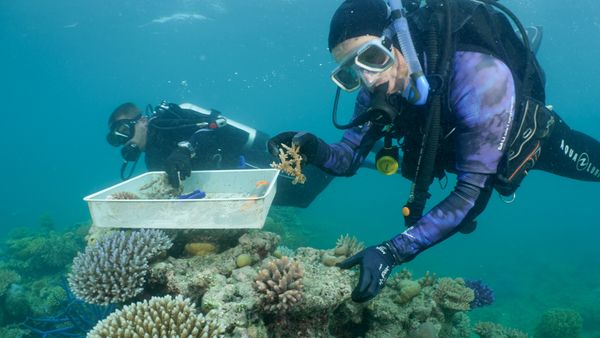The unsung heroes of the Great Barrier Reef will become the face of a nationwide tourism campaign designed to rally Australians to help protect the 2,300km World Heritage Listed wonder that lies on their doorstep.
Speaking ahead of World Nature Conservation Day (28 July 2024) and just days after The World Heritage Committee commended Australia for its efforts to protect the Reef, Queensland Premier Steven Miles said there is nothing more important than conserving “our wonderful Great Barrier Reef”.
“Just this week the World Heritage Committee has again decided to keep the Great Barrier Reef on the world heritage register and that’s in recognition of the efforts that we are going, to protect the reef,” said Premier Miles
“We want people to be passionate about protecting the reef and the way to get passionate about it, is by seeing it.”
The ‘Great Things Are Happening Here’ campaign will run from 11 August across TV, digital, BVOD, social and print media platforms. The campaign will highlight the people behind some of the sustainable initiatives while encouraging visitors to see the Reef firsthand.
Queensland Minister for Tourism and Sport, Michael Healy MP added that the industry has shouldered an untold amount of time and money to help the world’s largest living organism and it’s time to proudly share these great initiatives with others.
“The Great Barrier Reef is the world’s largest living natural wonder. Every year, we get over two million visitors from around the world. It employs 64,000 Queenslanders and it generates over $6.5 billion. It is iconic in so many ways,” said Minister Healy.
“Dozens of high standard tourism operators are doing great things. They’ve funded floating laboratories to support scientific research, provided the science community with vessels to access the Reef, helped rescue and rehabilitate turtles, housed a coral biobank with just about every coral species known, and supported Eye on the Reef programs that encourage snorkellers themselves to monitor marine life,” said Minister Healy.
The Master Reef Guides program, developed in partnership with Tourism and Events Queensland, the Great Barrier Reef Marine Park Authority (Reef Authority) and the Association of Marine Park Tourism Operators (AMPTO) is one of the many initiatives supported by the tourism industry.
Now numbering more than 120, these Master Reef Guides share the wonders of the marine park with many of the two million annual visitors to the Reef. Their role as storytellers and translators of science is to provide visitors with up-to-date information on what’s happening on the Reef and to encourage everyone to adopt more sustainable practices in their everyday lives.
They also work collaboratively with industry and science to create stewardship solutions to protect the Reef.
One shining example is the team at Reef Magic Cruises’ whose five-year study carried out in collaboration with Mars Sustainable Solutions aims to stabilise coral to cyclone-impacted rubble patches.
Led by Master Reef Guide and phD scholar, Dr Eric Fisher, the team has planted 439 reef stars on Moore Reef, 250 reef stars on Hasting Reef and has a permit for 200 more. The aim is to regrow corals and attract the wild and wondrous.
“The program has been incredibly successful. Within 18 months (of transplanting) we see 50 percent increase in coral growth. (After) 3 to 4 years, we can’t even see the reef stars. There’s almost a half a metre of coral growth on top,” Dr Fisher said.
Similarly, the team at Wavelength Cruises operating out of Port Douglas has taken a novel approach to coral regeneration. In partnership with scientists from the University of Technology Sydney, dive instructors and crew members tend to underwater coral gardens, transplanting fragments of coral onto once barren parts of a reef for regeneration.
Eight other Great Barrier Reef operators have since signed up for the Coral Nurture Program, attaching a combined 120,000 coral fragments to reef sites to date.
Brittany Wassing, a Senior Marine Biologist with Great Barrier Reef Biology, believes that visitation to the Reef has dual benefits. It supports reef management and it encourages travellers to make behavioural changes.
“Every single day, we get to head out to the Reef and take guests from all around the world to see the beautiful World Heritage Site that is right on our doorstep,” said Ms Wassing.
“We need everybody to come out and visit the Great Barrier Reef. That assists the Great Barrier Reef Marine Park Authority (with) thousands, millions of dollars, towards helping the Reef.”
She said through this experience, travellers “are going to learn to love something and then go home and make changes in (their) day-to-day life to help the Great Barrier Reef.”
For more information on the Great Barrier Reef and to plan a holiday to this World Heritage Listed Wonder visit queensland.com/greatbarrierreef.















